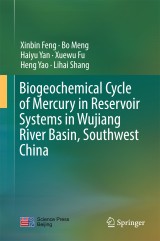Details

Biogeochemical Cycle of Mercury in Reservoir Systems in Wujiang River Basin, Southwest China
|
149,79 € |
|
| Verlag: | Springer |
| Format: | |
| Veröffentl.: | 09.11.2017 |
| ISBN/EAN: | 9789811067198 |
| Sprache: | englisch |
Dieses eBook enthält ein Wasserzeichen.
Beschreibungen
<p>This book presents an intensive study on the biogeochemical cycle of mercury in a river-reservoir system in Wujiang River Basin, the upper branch of the Yangtze River. Six reservoirs located in the mainstream of the Wujiang River and their corresponding inflow/outflow rivers were selected for inclusion in this study, which was conducted by researchers from the Institute of Geochemistry, Chinese Academy of Sciences. The concentration and distribution of Hg in reservoirs (the water column, sediment, sediment pore water), inflow/outflow rivers of reservoirs, and wet deposition in Wujiang River Basin were systematically investigated, and measurements were taken of the water/air exchange flux of gaseous elemental mercury (GEM). On the basis of the data gathered, a detailed mass balance of total mercury (THg) and methylmercury (MeHg) in the six reservoirs was developed. In addition, the book identifies the primary factors controlling Hg methylation in the river-reservoir system in WujiangRiver Basin. The accumulation and bio-magnification of Hg species within food chains in reservoirs and human health risk of MeHg exposure through fish consumption are also included in this book.</p><p><br/></p>
<p>Analysis of Hg species in environmental samples.- Wet deposition flux of total and methyl mercury in Wujiang River Basin.- Water-air mercury flux in reservoirs.- Mercury in inflow/outflow rivers of reservoirs.- Mercury in reservoirs in main stream of Wujiang River.- Mercury mass balance in reservoirs with different ages.- Bioaccumulation of Mercury in Food chains of reservoirs.- Primary factors controlling Hg methylation in reservoirs.</p>
<p> </p><p><b>Xinbin Feng</b> is a Professor of Environmental Geochemistry at the State Key Laboratory of Environmental Geochemistry, Institute of Geochemistry, Chinese Academy of Sciences, China. He received a BS degree in geochemistry from Department of Geology, China University of Geosciences (Wuhan), China; a master’s degree and a doctorate in Geochemistry from the Institute of Geochemistry, Chinese Academy of Sciences, China.</p><p>Dr. Feng’s scholarly activities have been found in the areas of Biogeochemical cycling of heavy metals in the environment and health impacts, Non-traditional stable isotope geochemistry, and Remediation of heavy metal polluted environment. </p><p>He is the Associate Editor of Journal of Geochemical Exploration since 2014, Acta Geochimica since 2014, and Editorial board member of Science of the Total Environment (2006-2012), Environmental Toxicology and Chemistry (2008-2012), Journal of Environmental Sciences (2014-present), Atmosphere (2015-present). Heserved as conference Chair of the 9th International Conference on Mercury as a Global Pollutant (2009), conference Chair of the 17th International Conference on Heavy Metals in the Environment (2014), and member of Society of Environmental Toxicology and Chemistry, and the International Association of GeoChemistry. He is now serving as the Associate Director at Institute of Geochemistry, Chinese Academy of Sciences, China. </p><p><b>Bo Meng</b> is now an Associate Professor of Environmental Geochemistry at the State Key Laboratory of Environmental Geochemistry, Institute of Geochemistry, Chinese Academy of Sciences, China. He received a BS degree in geochemistry from Department of Geology, Northwest University, China and a doctorate in Geochemistry from the Institute of Geochemistry, Chinese Academy of Sciences, China. Dr. Meng’s scholarly activities have been found in the areas of Biogeochemical cycle of mercury in the mercury sensitive ecosystems (e.g. river-reservoir ecosystem, rice paddy, mercury mining area) and health impacts. His scholarly contributions appeared in Environmental Science and Technology, Journal of Agriculture and Food Chemistry, Environmental Pollution, Biogeosciences, Chemosphere, Environmental Toxicology and Chemistry, and Journal of Environmental Quality, among others.</p><p> </p><p> </p>
<p>This book presents an intensive study on the biogeochemical cycle of mercury in a river-reservoir system in Wujiang River Basin, the upper branch of the Yangtze River. Six reservoirs located in the mainstream of the Wujiang River and their corresponding inflow/outflow rivers were selected for inclusion in this study, which was conducted by researchers from the Institute of Geochemistry, Chinese Academy of Sciences. The concentration and distribution of Hg in reservoirs (the water column, sediment, sediment pore water), inflow/outflow rivers of reservoirs, and wet deposition in Wujiang River Basin were systematically investigated, and measurements were taken of the water/air exchange flux of gaseous elemental mercury (GEM). On the basis of the data gathered, a detailed mass balance of total mercury (THg) and methylmercury (MeHg) in the six reservoirs was developed. In addition, the book identifies the primary factors controlling Hg methylation in the river-reservoir system in WujiangRiver Basin. The accumulation and bio-magnification of Hg species within food chains in reservoirs and human health risk of MeHg exposure through fish consumption are also included in this book.</p>
Gives a comprehensive study on the biogeochemical processes of mercury in a river reservoir system in China Provides fundamental data concerning the status Hg contamination in river-reservoir ecosystem in Wujiang River Basin, Southwest China Demonstrates that the Hg biogeochemical dynamics in reservoirs in Southwestern China are different from reservoirs in Europe and North America Includes supplementary material: sn.pub/extras
<p>Gives a comprehensive study on the biogeochemical processes of mercury in a river reservoir system in China</p> <p>Provides fundamental data concerning the status Hg contamination in river-reservoir ecosystem in Wujiang River Basin, Southwest China</p> <p>Demonstrates that the Hg biogeochemical dynamics in reservoirs in Southwestern China are different from reservoirs in Europe and North America</p> <p> </p>

















